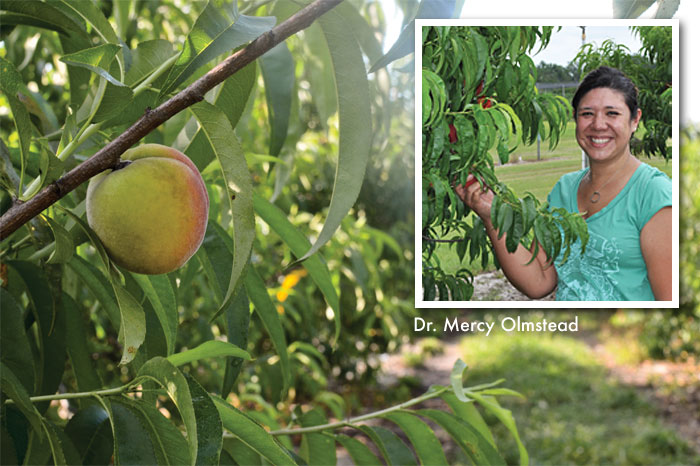Overcoming challenges and researching the way to future success
AN UNUSUALLY WARM WINTER is putting the bite on peach growers across the South. Harvests came in late throughout Florida, where many growers saw zero chill hours and record-breaking warm temperatures according to the National Oceanic and Atmospheric Administration (NOAA).
“It’s been a tough season this year,” says Dr. Mercy Olmstead, assistant professor at University of Florida/IFAS. “It’s just like the blueberries and other crops that require a little chill; we were delayed in bloom, and so it delayed our season by about two to three weeks.”
But peaches aren’t just ripening late; yields are down also. Grower Brandon Rafool reports overall peach production at his farm down a whopping 80 percent the past two years. “We are going to try to keep the health of the orchard up, but we are going to keep an eye on the costs because of the reduced crop,” says Rafool.
Unless growers or experts can come up with a weather machine to put a chill in the air next winter, there’s not much they can do. But Dr. Olmstead observes that researchers at the University of Florida have a seedling selection orchard down in Fort Pierce that might help. Under the guidance of Dr. Jose Shapiro, the selection orchard is being used to develop varieties that set well under high nighttime temperatures.
Despite the late and low yield, this season’s peaches reportedly rank high on the taste scale. “I just tasted a bunch of varieties yesterday and I would say that the only thing climate really impacts is the fruit size,” says Dr. Olmstead.
Great taste is one of the advantages Florida peaches have over the competition. Rafool notes that Chilean peaches are picked when they’re green, and then are gassed during shipping, reducing quality of taste. Contrastingly, Florida peaches have a high sugar content, and the sandy soil produces a great product for plants that can be sustainable on that type of soil. Plus, Florida peaches have a longer shelf life. “I had one in the refrigerator for ten days and I picked it out and it’s just great,” says Rafool.
Growers and researchers alike agree that it’s the taste that will win consumers over. “The taste is excellent. You can take a Florida peach and even toward the end of the season compare it to the first of the California harvest and consumers will come back for the Florida stone fruit,” says Dr. Olmstead. But, she adds, objectively speaking, it’s the state’s ability to get the first domestic fruit on the market that gives Florida growers their true advantage.
Despite great-tasting fruit that’s hitting the shelves before the competition, Florida growers are still facing a notoriety problem. “I feel like the market could be a lot more successful,” says Rafool. He believes he and other peach growers are acting as guinea pigs, and they would do better if they had additional advertising. Unfortunately, they don’t have money to spend on advertising as a fledgling industry. And that’s the problem; so they rely on the Fresh From Florida brand for help. Dr. Olmstead agrees. “The greatest challenge right now is marketing.” And what’s the second greatest challenge? To have a variety that does well under high nighttime temperatures. “I think they’re very good growers and they can adapt their cultural practices to produce high-quality fruit. It’s just that the people don’t know that we grow peaches in Florida,” adds Dr. Olmstead.
Dr. Olmstead’s office has received funding through the Florida Department of Agriculture and Consumer Services to look at marketing strategies for the Florida peach industry. They are hopeful, and expect to use the results from that research, in about a year and a half, to expand the market for Florida peaches. Olmstead is optimistic, because they now have the resources to develop fruit for warm climates, with warm nighttime temperatures. She says they have had the resources for three or four years and she thinks the first really good selections are being made. She believes that in five to ten years, they will have some exceptional varieties for the Florida industry — once those selections are tested and they are confident in their yields, fruit sizes, and fruit quality, and they are sure there are no major diseases.
Looking ahead to next season, Rafool concludes, “I hope for some more chill, and pray a lot, I guess.”
To growers who may feel discouraged, Olmstead adds, “We’re in it for the long haul, and we have resources dedicated along with breeders and myself in the UF/IFAS Extension for applied research that will continue to work for the growers here in Florida.”
CREDITS
article by BONNIE JOHNSON
photos by LEAH BEANE

